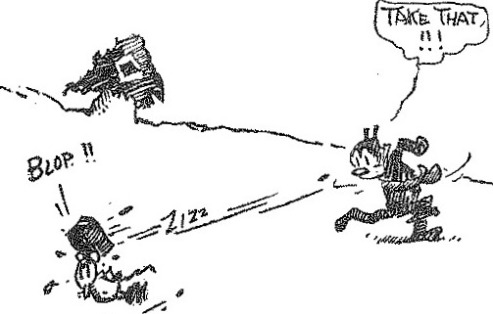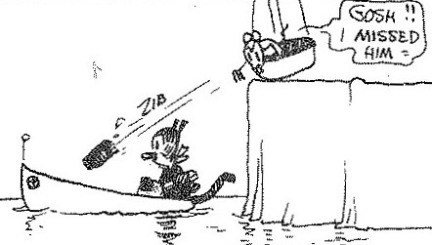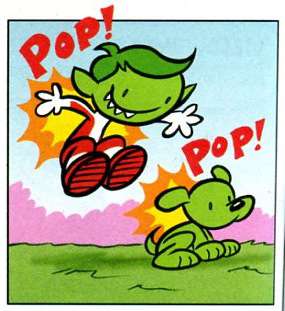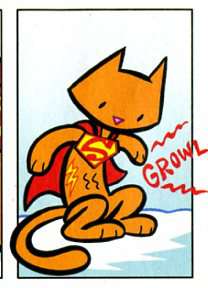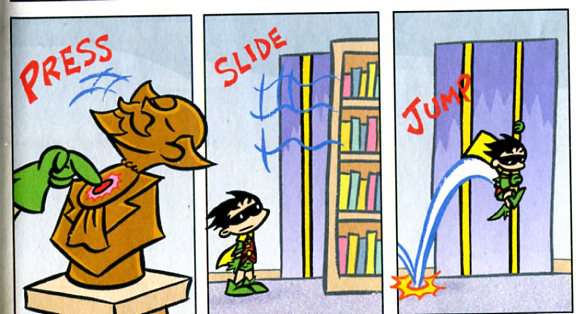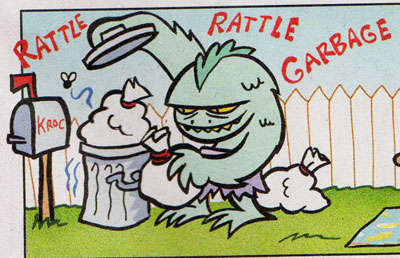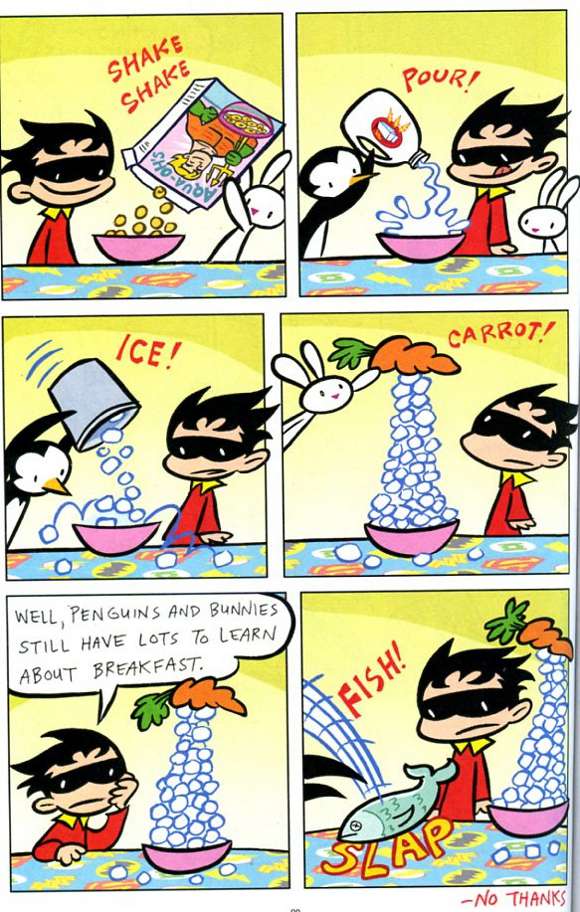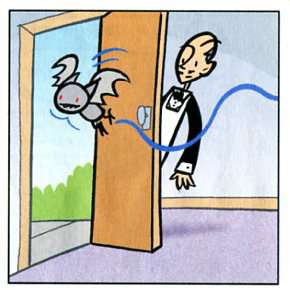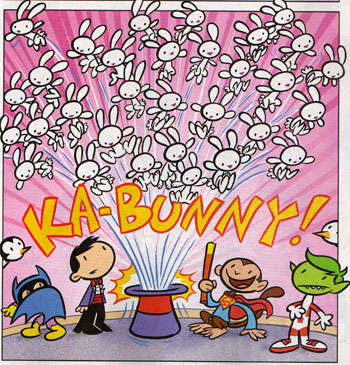Welcome to the third post in the Pencil Panel Page roundtable on George Herriman’s Krazy Kat. We are glad to have found a new home here at Hooded Utilitarian, and as Adrielle said in her inaugural post, you should dive into our archives here.
Since there has been some concern expressed on the Hooded Utilitarian site about the state of linguistic analysis, I wish to start my post on Krazy Kat with a note about the linguistic analysis of comics in general. As a linguist, I am most interested in the way that linguistic codes function in comics. I concentrate on the analysis of dialogue using methods borrowed from conversation analysis, primarily but not exclusively to highlight the interrelationship of language and identity. You might take a look at my essay on verbal camp in the Rawhide Kid as an example. But in addition to discourse analysis, and especially for my posts on Pencil Panel Page, I draw broadly on morphology, lexical semantics, dialect and register, as well as principles of bilingual code-switching, among others. Some commenters on Hooded Utilitarian have cited Hannah Miodrag’s book, Comics and Language (2013); Adrielle’s post two weeks ago mentions it. I would also like to note that I edited a collection of essays called Linguistics and the Study of Comics, published by Palgrave in 2012. You can read the table of contents and the introductory chapter here. My understanding is that Neil Cohn has a new book in the works, as well, about visual language. This is a very exciting time to be a linguist and to have interest in comics! And for those of you who are concerned about the dearth of linguistic analysis in comics, never fear! Much more is coming.
And now—on to language and sound in Krazy Kat. The point of Miodrag’s chapter on Herriman is ‘sidelining the visual (and thematic) content in favor of linguistic [in order] to illustrate how comics might truly be approached as literature, and to present a more convincing argument than has previously been achieved for their literary potential’ (p. 21). Some people will agree with Miodrag that comics are literature, and her goals are laudable. But for linguists, the point of a linguistic analysis of comics has very little to do with proving their literary worth. For me, a linguistic analysis demonstrates the nature of comics as comics and their relationship to linguistic systems. The aim is not to use linguistics to measure the nature of comics as literature or architecture or fine art or anything else.
But Miodrag does make some fine points in her discussion of arbitrary minimal units, which are essential in understanding linguistic systems. The arbitrariness of language can be discovered at the phonetic level: with just so many vowels available and a larger but nevertheless limited number of consonants, the tiny phonetic inventory of human speech sounds must necessarily be manipulated to produce vast numbers of unique combinations ranging across more than 6000 languages. (See Ethnologue for more about the world’s linguistic diversity). Depending on the dialect, English has roughly 12 to 14 vowels; other languages have more, others fewer. What this means is that phones cannot have frozen or static or essential functions: their functions are assigned by the speech communities that use them, and those functions always change.
Arbitrariness, of course, may also be illustrated at the morphological, syntactic, and lexical levels. Whether we call it chicken or poultry or fowl, we know that those words refer to a type of bird used around the world for food. Eventually, we’ll call that same bird something else, because languages change and the sign that we use to refer to that type of bird is arbitrary. We could even call it frindle if we wanted to.
Most linguists agree, though, that not every single unit in language is arbitrary. Sometimes, a syntactic form is only semiarbitrary. Consider these two sentences:
(a) We had pizza and beer after we finished our workout at the gym.
(b) After we finished our workout at the gym, we had pizza and beer.
The events here occur in the same order chronologically, but they are reversed syntactically. But in (b), the syntactic order of events mimics the chronological order of events. Workout at the gym comes first, pizza and beer comes next, so the order of (b) is not entirely arbitrary.
I think that the limits of arbitrariness play an important role in Krazy Kat. Like many comics creators, Herriman uses sound effects to provide an auditory element to the page. Many linguists consider human sounds meant to mimic sounds from the environment as semiarbitrary in nature. Even though a rooster says cock-a-doodle-doo in English, says quiquiriquí in Spanish, and says gokogoko in Cantonese—even though these are different phonetic representations—they are not completely arbitrary. They in some sense mimic the acoustic sounds outside the linguistic system.
Herriman’s use of sound effects is fascinating, and a quick survey of the Sunday comics (Fantagraphics, 1916–1918) demonstrates his playfulness and creativity. I’d like to consider one particular sequence when Krazy Kat and Ignatz Mouse switch bodies. In the opening panel of the September 9th strip, we see a Krazy Kat throw a brick and hit an Ignatz Mouse with it:
The sound effect of the brick sailing through the air is Zizz. (Zizz probably because bricks don’t go fap fap fap or sklircha sklircha when they nudge their way through air molecules.) When the brick strikes Ignatz, the sound is Blop!! Naturally, the other characters in the strip are mystified. They simply cannot believe that the mild-mannered, gentle, and kind Krazy has turned the tables on that spiteful bully Ignatz. The mystery is so deep that Herriman takes three Sunday comics to reveal the secret to readers.
In the second installment, on September 16th, the strip opens with a memory. It is an inset of the same event shown on September 9th, with a couple of different details:
This time, when Krazy throws the brick, it says Jazzzz. And when Brick hits Ignatz, the sound is MBOB. There are a few other differences, too, like Krazy’s stance and the absence of speech on 16 September. (In both scenes, Krazy throws the brick from right to left: see Roy Cook’s earlier post about this.)
In the third installment, on Sunday 23 September, Herriman solves the mystery and puts Krazy and Ignatz back in their proper roles. In scene 12, we witness (the real) Ignatz throwing a rock at (the real) Krazy. The sound of the rock sailing through the air is Jazz, and the rock strikes Krazy with a Pap. The anomalous characters and actions have been resolved, and all is right with the world again.
Miodrag is right when she argues that Herriman pushes the boundaries of the standard English linguistic system by making full use of the arbitariness of minimal units. The same can be said for his sound effects. But not all of Herriman’s sound effects push the boundaries of the units. He often uses a standard(?) pow or bop or bam or zip, but his tool kit is wide-ranging. Herriman’s use of sound effects is highly creative. Just as he plays with arbitrary minimal units in creating the linguistic repertoire of characters, he also plays with the representation of nonlinguistic sound. Of course in Krazy Kat, bricks don’t always make sounds when they fly through the air or hit someone on the head. And at times, even on the same page, the sound effects for the same action are variable:
Ignatz throws a brick (from right to left), and the sound effect is Zib. Later, on this very same page, the sound effect for a similar action is Bzip.
My main question on arbitrariness has to do with the sound jazz. Unlike bam or fwip, jazz is a word that has standing in other areas or domains of English. Its precise etymology is unclear, but early uses of the word associate it with such activities as baseball. (The American Dialect Society voted it the Word of the Century in 2000.) Nowadays, it is most often associated with an important musical genre. I believe Herriman uses jazz as the sound of an object whizzing through the air not because of its arbitrariness but because of its multiple meanings. Herriman plays with these multiple meanings—the arbitrary ones—that jazz contains and brings them to bear on the semiarbitrary representation of enivronmental sound in comics. Maybe the relationship between Krazy and Ignatz needs something more than a regular old sound effect, and Herriman uses jazz as a way to give their relationship a little something extra. Maybe the sound of the brick is more than physically acoustic: maybe it’s music to their ears.
Earlier comments on our Krazy Kat roundtable express the sense that Herriman’s comic is best read slowly, in small doses. A slow reading allows us to savor the visual and the verbal, but we also get to revel in the playful, almost-but-not-quite arbitrary representation of acoustics. As much arbitrariness as we sometimes see in the language and behaviors of Krazy Kat characters, as well as the background scenes, we know that Herriman doesn’t go too far afield lest he lose the reader in a fog of inscrutability. But Herriman does make his readers work for it, and as a result of this slow, sumptuous reading, we are very richly rewarded.

